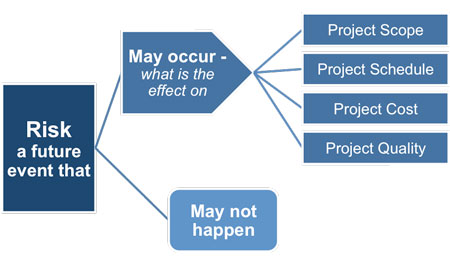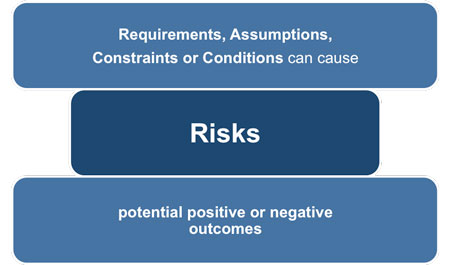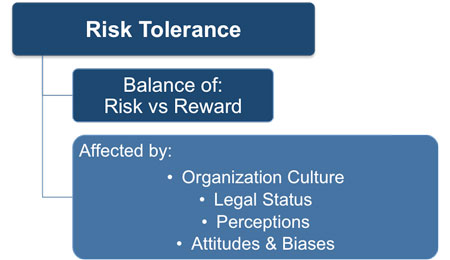Managing Project Risk
A risk is a future event that may or may not happen, but if it does occur it will have an effect on project scope, schedule, budget, or quality. It may have one or more causes and, if it occurs, it may have one or more impacts.
All project activities carry some element of risk, which are uncertainties about them that could affect the project for better or worse. It is important to understand the difference between business risks and project risks. What a project manager needs to know is what is the likelihood a risk will occur and if it does what will it impact as this affects the project plan.
 |
What is certain is that if the risk happens in the future it will have an effect on project scope, schedule, cost, or quality. It may have one or more causes and, if it occurs, it may have one or more impacts. All project activities carry some element of risk, which are uncertainties about them that could affect the project for better or worse.
The important distinction that must be understood is the difference between business risks and project risks. Business risks are more general and relate to the organization, whereas project risks relate specifically to the project objectives.
Business risk implies uncertainty in profits or danger of loss and the events that could pose a risk due to some unforeseen events in future, which causes business to fail. (Wikipedia)
For example,
• Project scope - to build the stadium to the agreed specification within an agreed timescale and budget.
• Project risk - that the building costs may be higher than expected because of an increase in materials or labor costs.
• Business risk - even if the stadium is constructed on time and within budget that it will not make money for the business.
This could be because of lower than expected ticket sales or higher than expected maintenance costs. These risks exist outside of the scope of the project. Risks are caused by a requirement, assumption, constraint, or condition that creates the possibility of negative or positive outcomes.
 |
Continuing the example above: a risk cause would be a change in health and safety legislation during the build phase. Whereas a risk outcome would be increased costs to modify the parts of the stadium in accordance with the new legislation before it can be used.
Project Impact on cost, schedule and performance needs to assessed:
1) Shortage of skilled personnel due to demand by other building projects.
2) Unexpected cost of inspection & license.
3) The build of the affected parts of the stadium can be brought forward to finish project on time.
Risks include both threats and opportunities that project managers must assess. Opportunities do have uncertainty associated with them, but they should be grasped, and action taken to ensure that they are realized.
Threats have potentially negative impacts that the project management team should strive to mitigate. Organizations and stakeholders are willing to accept varying degrees of risk. This is called risk tolerance. Risks that are threats to the project may be accepted if they are in balance with the rewards that may be gained from taking them.
For example, using unproven productivity-boosting software is a risk taken in the expectation that the work will be completed more quickly and with fewer resources. The risk of the software not performing as advertised would need to be considered as part of the risk assessment.
All organizations have a 'risk tolerance' that is affected by their legal status and their culture. For instance, a pension fund is likely to be more risk averse than a small start up company. In all cases, attitudes to risk are driven by perception, tolerances, and other biases, which should be made explicit wherever possible.
 |
To be successful, the organization should be committed to address risk management proactively and consistently throughout the project. A conscious choice must be made at all levels to actively identify and pursue effective risk management during the life of the project. Communication about risk and it's handling should be open and honest.
Risk exists the moment a project is conceived. Moving forward on a project without a proactive focus on risk management increases the impact that a realized risk can have on the project and can potentially lead to project failure.
You may also be interested in:
Project Risk Management | Creating a Risk Management Plan | Identifying Project Risks | Performing a Risk Analysis | Planning and Controlling Risk Responses.
|
|


